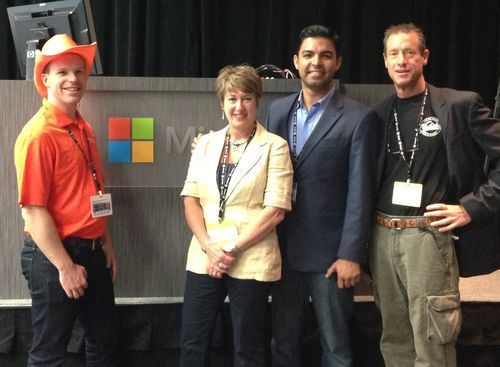David Meerman Scott's Blog, page 73
July 18, 2013
The irrational value of time
At airports, I’ve noticed an interesting phenomenon illustrating people's lack of rational behavior regarding money.
 Some airlines now offer passengers the ability to purchase a bypass of the main TSA security line. For example, the JetBlue Even More Speed option costs $10 or $15 per passenger and allows you to use a special premium passenger security lane.
Some airlines now offer passengers the ability to purchase a bypass of the main TSA security line. For example, the JetBlue Even More Speed option costs $10 or $15 per passenger and allows you to use a special premium passenger security lane.
At some busy airports like Orlando, I figure I’ve you could save on average some 30 minutes by doing this. The main lines are even longer during peak travel times. Yet, the Even More Speed line isn’t popular. Few people take advantage of this opportunity.
This suggests the vast majority of people value their time at less than $20 per hour.
Yet at the very same airports, I’ll witness overbooked flights resulting in airline representatives offering $300 vouchers to passengers willing to give up their seats. All you need to do to qualify for $300 worth of future travel credit is change to the next flight, which typically departs just a few hours later.
I’m always amazed at how few people take up this offer. Sometimes, the airline needs to up the ante because there are no takers. I feel like screaming “Hey people! You can make $150 an hour here!”
It’s amazing that people won’t pay $10 to save a half hour of wait time but those same people won’t take $300 in exchange for waiting an extra two hours.
Exactly how do we value time?
Humans are irrational about money
I suspect the reasons for this disconnect is that on one hand we are reluctant to pay $10 right now for the ability to save a half hour of line waiting. However, we don’t see the value of waiting for two hours to get a $300 reward at some point in the future when we next want to travel.
There is a huge disconnect at work with ramifications for how we go about our personal life. Giving financial decisions just a little rational thought might mean we make a different choice regarding money.
Marketing, sales, and money
Many marketers create products and services and associated advertising to take advantage of our irrationality regarding money. Is getting $1,000 off the price of a new car “saving a thousand dollars”? Of course not! It’s spending $25,000 on a car instead of $26,000.
Companies like Amazon.com and Macy’s and Hotels.com have trained us to never, ever, pay “full price.”
But what is full price anyway? In many industries, it’s an arbitrary number that companies discount from because they know people are irrational about money.
July 15, 2013
JetBlue Badges gamification marketing fails to take off
 Gamification can be a great way to encourage loyal customers to share on social networks. It is an especially valuable form of marketing in the travel business.
Gamification can be a great way to encourage loyal customers to share on social networks. It is an especially valuable form of marketing in the travel business.
Several times this year, I talked about how Ocean Frontiers dive resort in the Cayman Islands uses their Green Short Challenge to get their fans to share images on Facebook.
This form of marketing works! I found out about Ocean Frontiers in this way and booked a dive trip for my daughter and me as a result.
JetBlue Badges
JetBlue recently introduced their version of Gamification called JetBlue Badges. While it is a great idea, the execution means it will fail to take off.
I frequently fly JetBlue and subscribe to their email list. They alerted me to the new JetBlue Badges program and I was eager to sign up. I was imagining a Foursquare-like approach where I could gather badges for each city I have flown via JetBlue. It must be about ten or so cities by now.
A quickly found a leaderboard where you can see how you compare to other JetBlue Badges members. You can link to your Facebook or Twitter to share your progress with your friends.
It all sounds good on the surface...
Gamification in travel is smart marketing
Frequent travelers love to talk about their adventures and frequently do so on social media. For travel related businesses, making a game of your services makes sense.
People like me like to “check off the list” such as when I visited North Dakota several years ago and was able to say I have visited all 50 states. Heck, there is even a club for those who have visited 100 countries.
The best example of this approach is the Cities I’ve Visited app from Trip Advisor, a Facebook app with 1.2 million likes. Wow.
Clearly, Gamification in travel works.
Why JetBlue Badges falls short
There are a number of reasons why JetBlue’s efforts are likely to fail. Here are four:
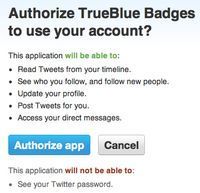 Too much personal information is required to play
Too much personal information is required to play
JetBlue seems to require members to sign up via Facebook and / or Twitter to use the game properly. When I went to link with my Twitter, I got an ugly message saying I was authorizing JetBlue to “update your profile” and “post tweets for you.” No way!! I absolutely refuse to allow apps like this.
This is a mistake because if I want to share I will. You shouldn’t force people because many will simply not play.
Existing travel data is not included
As I went to sign up for the JetBlue Badges, I had visions of my map lighting up with all the cities I’ve traveled to with JetBlue. After all, I am a member of their TrueBlue frequent flyer program, therefore they have records of the cities I have flown to with them. Unfortunately, it starts when you sign up for JetBlue Badges.
I think it is a mistake to start the clock when you join JetBlue Badges, not when you joined the JetBlue frequent flyer program.
There is too much partner marketing
The badges that the game pushes from the beginning are mostly partner related. You can get a badge for having a JetBlue American Express card or a JetBlue MasterCard. You can get a badge for Hertz rental cars or Hilton Hotels.
This is a mistake because it puts those partners in front of the true game, which is to travel to a lot of places on JetBlue. What would JetBlue rather have: Me going to a new city? Or me getting a credit card from them?
You need to be a TrueBlue frequent flyer to see the game information.
As far as I can tell, JetBlue Badges game information, FAQs, leaderboards and other information are only accessed if you are a member of the JetBlue frequent flyer program.
This is a mistake because new customers might join if they see the game.
Gamification in your market
As you consider a game, make sure it is open and free and non-restrictive. Allow people to play a fun game and they will talk up your brand like Ocean Frontiers. Make it restrictive and the effort will not take off, like I predict JetBlue Badges won't.
Hey JetBlue! You can always change the rules. I’m flying you on Thursday this week. How about making it fun so I play, not restrictive so I don’t?
July 12, 2013
LeVar Burton on the intersection of education and technology
I had an opportunity to spend a few minutes with Emmy and Grammy award winning actor and entrepreneur LeVar Burton after a taping an episode of Bryan Elliott’s Behind the Brand show. It was a fun group that also included Mike Rowe from television’s Dirty Jobs.
LeVar Burton got his start at age 19 playing the young Kunta Kinte in the fabulously successful 1977 ABC television miniseries Roots. He also played Lt. Commander Geordi La Forge in Star Trek: The Next Generation and has had appeared in many other movies and TV shows. He’s known to millions of kids as the host of the PBS children's program Reading Rainbow.
Like me, LeVar is also a supporter of the Astronaut Scholarship Program and Apollo space geek.
In this video interview, I ask about LeVar’s newest entrepreneurial venture: the new digital version of Reading Rainbow available on the iPad. LeVar is passionate about the intersection of education and technology. We also discuss social media - @levarburton has 1.7 million Twitter followers - and how social media can be used as a tool to reach mothers who might purchase the Reading Rainbow app for their kids.
Direct link to LeVar Burton on the intersection of education and technology on YouTube.
Thanks to Bryan Elliott for having me on the show. It was a fun day indeed.
July 9, 2013
When things go wrong
I frequently speak at conferences and obsess over the details to get things right. I wrote about some of the obsessions in my blog post Top ten tips for incredibly successful public speaking.
But I also plan for things to go wrong.
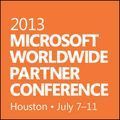 Yesterday I had a mini disaster when I spoke at the Microsoft Worldwide Partner Conference in Houston.
Yesterday I had a mini disaster when I spoke at the Microsoft Worldwide Partner Conference in Houston.
The problem, you ask?
Well, the session was supposed to be today at 3:00, NOT yesterday.
I get a call from Justin Pirie from Mimecast who worked with Asher Mathew from Avalara to plan the “Emerging Leaders” track: “David? Where are you? You go on in one minute!”
“What?!” I was just arriving at my hotel in my grubby travel clothes: worn out cargo pants and a surfing t-shirt. “I’m speaking tomorrow at 3:00,” I said.
“No, it’s now!”
Holy crap. I have no time! I’m a mile away and haven’t registered for the conference. I don’t know where to go. I’m not dressed properly.
I could have just said it wasn’t my fault. I could have said I wasn’t ready. There were a bunch of reasons why I could have said I can’t make it.
The show must go on!
The Microsoft Worldwide Partner Conference is 10,000 plus people – a huge event with many rooms. I decide to go for it. This won’t be easy.
“I’m on my way, Justin. Stay on the line!”
I run to the hotel’s taxi station and pause for 30 seconds to grab a sport coat from my bag. I give the bellman a $20 bill and my business card and ask him to hang onto my bag.
Dammit. There’s a line for taxis.
In a move I would never do under any other circumstances, I give the guy in the front of the line a twenty and say it’s an emergency and I need the next cab. He takes the cash and laughs at me.
I’m still on the phone with Justin who tells me which door of the Houston Convention Center to have the taxi go while I’m juggling the phone and my money.
“Justin, what’s happening?” I want to know what the people in the room are doing.
“People are waiting,” Justin says. “It is a full room.”
Yikes. What am I doing? “Nearly there!”
We make it to the venue in five minutes. No time for change, I hand the driver a twenty and run in the door. Asher is there and had organized a security person to escort me through to the room because I had not yet gotten my badge.
I arrive in the room at 3:13, just fourteen minutes after hearing that I was due on stage. I look terrible in my surfer clothing. It takes about two minutes to set up the equipment as Justin introduces me.
Because I have so much adrenaline in my system from the mad dash, I give a very energetic talk and the people in the audience seem understanding to my lateness (which they didn’t need to be).
Be prepared
In your business, you can never anticipate every potential pitfall. How can you plan for your speech being a day earlier? But if you plan ahead and be aware of problems, you can react in real-time when one pops up.
Unlike many speakers who work the night before on their presentation, I had prepared my talk well before I arrived in Houston. I had everything with me (I carry my presentation slides on a memory stick from the moment I leave home). I knew my material.
I found out later that the cause of the mix-up was one of those multiple errors compounded because many people were involved. It was a chain of events that happened in such a weird way that no one person was at fault. It happens.
Fortunately this one worked out well in the end.
Here’s a shot from about an hour after the talk with the people who helped me pull off the mad dash to the venue. Left to right, Justin Pirie from Mimecast Megan Casey from Microsoft, Asher Mathew from Avalara, and me in my surfer clothing with a sportcoat to look halfway presentable.
Thanks Megan, Justin and Asher. We did it.
July 2, 2013
Building a fan base one download at a time
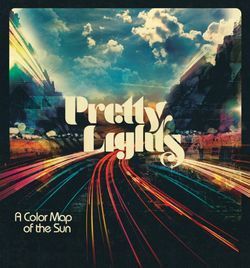 Today, the EDM artist Pretty Lights dropped his newest album A Color Map of the Sun.
Today, the EDM artist Pretty Lights dropped his newest album A Color Map of the Sun.
One way to get it is totally free from his site. If you're a music fan like me, check it out. In fact, many of his label's albums are free using this link.
Here's what he said this morning: A Color Map of the Sun has now officially been released! If you can, I encourage you to purchase a copy of the album digitally in iTunes or physically through PrettyLightsMusic.com, or at a local record store or download it at no cost below. Thank you to everyone who has supported PL by purchasing a copy of this record. I hope it is enjoyed!!! To see how this unique album was created, watch "The Making of" documentary HERE.
Building a fan base
So why make it free? To gain exposure, of course! If I recommended it, you probably wouldn't buy the album. If you heard a track in a dance club, you probably wouldn't buy the album. But you just might take a chance to download it for free and give it a listen.
And then maybe, like me, you'd buy a ticket to one of his many live shows. I caught him in Baltimore last month and it was a fun show with excellent music and a great light show as you can see from my Instagram below.
And then maybe you'd become a fan and talk Pretty Lights up on social media like I am here.
All because of a free download.
If you haven’t read it yet, my book World Wide Rave: Creating Triggers that Get Millions of People to Spread Your Ideas and Share Your Stories is now completely free as a PDF (with no registration required) and on Kindle, iPad, Nook, and Kobo ebook readers.
In World Wide Rave, I talk about how organizations of all kinds can use free content to drive action.
Album cover via Pretty Lights site.
Live shot by David Meerman Scott.
July 1, 2013
New Rules, new stories, new chapters
Today is the official publication date for the 4th edition of The New Rules of Marketing and PR.
For authors, "pub date" is exciting because it is when books ship from the online booksellers in the U.S. like Amazon and it is when the book appears on the shelves in American stores like Barnes & Noble. Books will be available worldwide in the coming weeks.
Direct link to Preview of the 4th edition of The New Rules of Marketing & PR by David Meerman Scott on Vimeo.
Of the four updates to New Rules, this 4th edition is the most comprehensive. It is completely revised and updated. I wrote new chapters on Newsjacking and marketing with images using tools like Pinterest and Instagram.
There are about 20 new stories of success too. To give you a taste of the sorts of new stories to expect in the 4th edition, I talk about how Service Dog Academy uses online video to reach buyers; how Ocean Frontiers uses Facebook to build an intensely loyal fan base; and how sharing photos via Instagram can help sell expensive products.
I've added so much new material it runs about 70 pages longer than the 3rd edition (which was also a major re-write). And because I deleted a bunch of older stories, it is probably 100 new pages.
Here is the press release from my publisher, John Wiley & Sons: David Meerman Scott Updates His Bestseller, "The New Rules of Marketing & PR," for Businesses Looking to Thrive in a More Visual and Direct Marketplace.
Many thanks for your support over the four editions. For an author, there is nothing better than being read.
June 28, 2013
Congrats 2013 graduates. You have choices.
 To the class of 2013: Congratulations on your graduation!
To the class of 2013: Congratulations on your graduation!
As you embark on the world we all share, you will face countless choices.
You can be like everybody else and release your balloon on command.
You can choose to hang on to your balloon and quietly dispose of it properly.
You can choose to make a bit of a ruckus by choosing not to accept your balloon while trying to convince those near you to not accept theirs either.
You can choose to quietly spend an hour on the beach cleaning up used balloons.
 You can choose to organize a group of your classmates to join you in cleaning up the beach.
You can choose to organize a group of your classmates to join you in cleaning up the beach.
In the weeks before graduation you could choose to create a social media campaign - enlisting your classmates, parents, teachers, and townspeople for support - to convince the school administration to eliminate the traditional balloon release.
Upon graduation, instead of finding a traditional job, you could choose to start your own nonprofit and name yourself executive director. If you live in the U.S. your goal could be to ban balloon releases in every state. You could get funding from surfing, boating, and fishing industry manufacturers as well as concerned citizens.
(If this interests you, I would gladly transfer the domain I just purchased - banballoons.org - to you at no cost, donate a small amount to get you going, and offer to sit on your advisory board.)
You have choices
Of course, this is not a post about balloons nor is it intended solely for 2013 graduates.
This is about the choices we all face every day. As you go through the world, think of those balloons. Don't automatically do what is expected. Consider the alternative choice. Choose to become a Linchpin.
Just because everyone is doing something, it isn't the best choice.
June 26, 2013
Communications Revolution 2007 - 2013
With the release of the 4th edition of my book The New Rules of Marketing & PR this week, I've been reflecting on the progress we've made as marketers and entrepreneurs in just a few short years.
We are lucky to be living in the middle of a communications revolution! It is now so much easier to reach buyers than in the old days.
I created this short presentation to illustrate how far we've come.
Communications Revolution 2007 - 2013 from David Meerman Scott
Direct link to Communications Revolution 2007 – 2013 on SlideShare.
Communications Revolution 2007 - 2013
Imagine, just a few short years ago as I was writing the first edition of New Rules in 2005 and 2006, Facebook was only for students and MySpace had four times as many users as Facebook. Now MySpace has only 32 million users to Facebook’s 1.1 billion.
Twitter didn't even exist as I was writing the first edition, nor did most social networks we use today including Instagram, Google Plus, Foursquare, and SlideShare.
How amazing that in just a few years, inbound marketing and social networking has become mainstream! We are truly living through a communications revolution.
The New Rules of Marketing & PR has sold 300,000 copies in English over four editions and is translated into 25 languages from Bulgarian to Vietnamese.
Thanks to Doug Eymer at EYMER DESIGN Laboratories + Think Tank for the design of the presentation.
June 25, 2013
NEW 4th edition of The New Rules of Marketing & PR
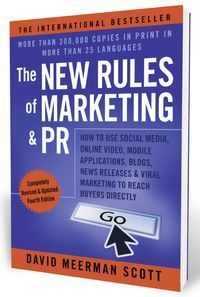 Today, the pre-order of the new 4th edition of The New Rules of Marketing & PR is the "Deal of the Day" at BN.com.
Today, the pre-order of the new 4th edition of The New Rules of Marketing & PR is the "Deal of the Day" at BN.com.
As such, if you purchase a copy at Barnes & Noble today or over the next week, it will be 50% off the cover price of $24.00. They will ship the book worldwide.
The official publication date is July 1, but some retailers such as Amazon.com and BN.com are likely to ship a bit earlier in the U.S. – most likely late this week. International booksellers will ship a bit later.
What's new with the New Rules
Of the four updates to New Rules, this 4th edition is the most comprehensive. The new edition has new chapters on Newsjacking and marketing with images using tools like Pinterest and Instagram. There are a bunch of new stories too. I've added so much new material it runs about 70 pages longer than the 3rd edition which was also a major re-write.
I'll be blogging about the changes in marketing over the past few years which required me writing thus updated 4th edition and I'll be releasing some free material on my blog over the next few days.
The New Rules of Marketing and PR originally published in 2007. Over the four editions, it has sold more than 300,000 copies and available in over 25 languages from Bulgarian to Vietnamese.
Thank you to all who have purchased previous editions!
June 20, 2013
Celebrate your content creators!
 My friend Rich Jurek points us to Karim Nafatni, a Dubai-based commercial airline pilot who is also an avid photographer and likes to shoot photos in the cockpit.
My friend Rich Jurek points us to Karim Nafatni, a Dubai-based commercial airline pilot who is also an avid photographer and likes to shoot photos in the cockpit.
As Karim says on his site, "being an airline pilot I got fascinated by the way the city looked from high levels."
The photos on Karim's site and his 500px feed are stunning. Others have noticed, with the UK's Daily Mail writing View from the top of the world: Passenger jet pilot's jaw-dropping photographs stunning vistas... taken from his cockpit at 35,000 ft and the Yahoo Blog Pilot showcases stunning photos taken from plane’s cockpit.
Embrace your content creators
Have you noticed what's missing in all of this? Nowhere in the photos, the articles, or on Karim’s site and photo feeds is there a mention of the airline he works for.
What a missed opportunity!
If I were a marketer at the airline Karim flies for, I’d love to talk up his photos. It humanizes the airline. It shows how that airline is different.
Seek out and celebrate your content creators! And realize it's likely they aren’t in the marketing department.
Photos via Karim Nafatni / 500px.com




